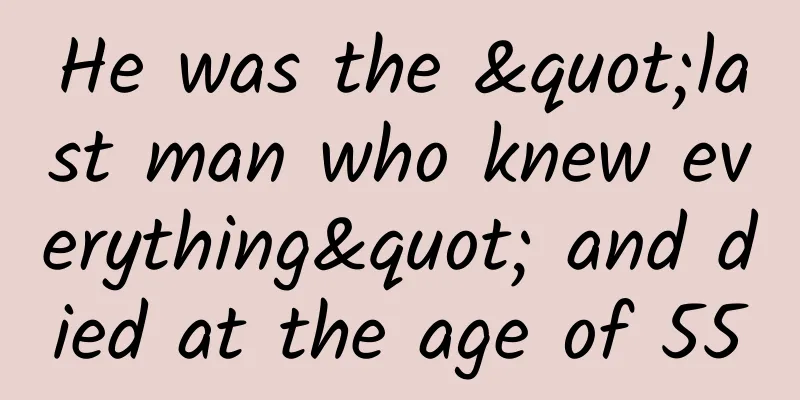He was the "last man who knew everything" and died at the age of 55

|
This article is the preface written by Royal Astronomer Martin Rees to Andrew Robinson's book "The Last Man Who Knew Everything". It introduces the profound knowledge, humility and social context of the British scientist and generalist Thomas Young - his achievements accompanied the institutionalization of science itself. In this era, our exploration of everything is broader and more profound. Therefore, we can never expect modern scientific generalists to cover such a wide range of fields as Thomas Young. 2023 is the 250th anniversary of Thomas Young's birth. This article is dedicated to this great scholar. By Martin Rees Translation | Leo "The experiment I am about to relate... may be repeated wherever sunlight reaches, and requires no other apparatus than materials which are readily available to every one." This was the opening statement of British scientist Thomas Young (June 13, 1773–May 10, 1829) when he described his newly designed double-slit experiment to members of the Royal Society in November 1803. His experiment revealed a nature of light, which is also one of the important cornerstones of today's quantum mechanics. Today, physics students around the world are familiar with the classic optical experiment, Young's slits, and his definition of elasticity, Young's modulus. But not everyone may be familiar with Thomas Young's other amazing achievements in science, which spanned everything from fluid mechanics to human vision. They may also not know that Thomas Young was a trained doctor and a self-taught linguist. Not only did he understand many ancient and modern languages, he also analyzed the vocabulary and grammar of about 400 languages and was famous for deciphering the text on the Rosetta Stone. "Encyclopedias take pains to describe Thomas Young as 'physicist, physician and Egyptologist'. Physics and physiology were his strengths, medicine was his specialty, Egyptology was his hobby. But his expertise went far beyond these already vast fields (of his time)," Andrew Robinson wrote in his book The Last Man Who Knew Everything. In fact, Thomas Young's work is indeed encyclopedic, and he is considered one of the most prolific and knowledgeable people in history. Cover of The Last Man Who Knew Everything Thomas Young was born in the 1770s and spent his early childhood in rural England. Even then, he showed extraordinary talent. The first chapter of this book outlines Thomas Young's ability to surpass his peers in language and mathematics. Although some "child prodigies" may become "not so good" as adults, Thomas Young was not like that. His talent and wide-ranging interests at an early age foreshadowed his lifelong talent. However, it all ended in 1829 when he died at the age of 55. Some of Thomas Young's achievements: Thomas Young became famous for demonstrating the interference phenomenon. He also advocated the wave theory of light, which contradicted the mainstream theory at the time, that is, the particle theory of light advocated by Newton. A versatile scholar, Thomas Young gave a series of brilliant lectures to the Royal Society in 1802-1803, which contained insights into mechanics and thermodynamics that were not fully understood until many years later. Thomas Young was also the first physicist to estimate the diameter of a molecule. Social atmosphere and spirit of inquiry For Thomas Young, the timing and location were right: at the turn of the 18th century, London’s social climate was vibrant and culturally inspiring. As Richard Holmes describes in his book The Age of Wonder, about science during the Romantic period: art and science were intertwined. The exploits of explorers and naturalists such as James Cook and Joseph Banks merged with the creativity of poets such as Samuel Taylor Coleridge and Percy Bysshe Shelley. Far from being severed between the “two cultures,” there was a close interaction between scientists, literati, and explorers. This spirit of inquiry dates back at least to the founding of the Royal Society in 1660. Founding members Christopher Wren, Robert Hooke, Samuel Pepys, and other “gentlemen of intelligence and curiosity” (as they put it) met regularly. Their motto was to distrust authority. They conducted experiments, dissected strange animals, and observed the world through newly invented telescopes and microscopes. They even transfused sheep’s blood into a human (the man survived). In addition to satisfying their curiosity, these scientific pioneers were also immersed in the practical agenda of their time: improving navigation technology, exploring new lands, and rebuilding cities after the Great Fire of London. Some of them came from strong religious backgrounds, and their scientific enlightenment came from Francis Bacon, who believed that scientists should pursue two goals: to be "Merchants of light" and to promote "the welfare of mankind." About a century later, the American Philosophical Society (APS) was founded in Philadelphia, with the goal of "promoting useful knowledge" and the polymath Benjamin Franklin as its first president. The Royal Society of the 18th century encouraged the inclusion of young talent. Thomas Young was elected a member in 1794 for a paper he submitted. The paper explored the structure of the eye and how it "adjusts itself for the perception of objects at different distances". He was only 21 years old at the time, and being elected a member so early on the basis of a paper was not as unusual as it is today. Although Thomas Young was active in the Society throughout his life, this may not have made much of a difference to him. In fact, many members at the time were wealthy amateurs who did not have many ambitions for scientific achievement. By the end of the 18th century, the Royal Society—like Oxford and Cambridge—was a languishing institution. But in the early 19th century, London’s strong scientific atmosphere led to the creation of other learned societies. Some were specialized, such as the Linnean Society and the Royal Astronomical Society. One, the Royal Institution (RI), founded in 1799, truly rivaled the Royal Society in influence. Scientific visualization: This image published in 1807 is an illustration of Thomas Young's 1802 lecture at the Royal Academy of Sciences. The image shows several optical phenomena, including the anatomy of the eye and the double-slit interference phenomenon. Image source: wiki The Royal Institution was funded by a well-read but cynical adventurer, Benjamin Thompson (Count Rumfod), who funded it enough to build a fine building on Albemarle Street in central London. Rumfod's most famous scientific contribution was his theory of heat, thanks to his experiments with guns and explosives. Through his research on the process of boring metal cannons, he realized that heat was not a substance, there was no such thing as "caloric", but rather energy generated by the vibration of atoms and molecules. Rumford envisioned that the Royal Institution would be more than just an institution for research and experimentation, but that its mission would include the dissemination of science to a wider audience. Indeed, the Royal Institution was blessed with two distinguished presidents, Humphry Davy and Michael Faraday. Both were brilliant scientists who also promoted the popularization of science through weekly “lectures”. These lectures attracted many of London’s elite and continue to this day, although with less fanfare. In 1801, Thomas Young became one of the first professors of the institution. Although his lectures were not as glamorous as Faraday’s, his lectures were comprehensive and detailed, and the publications of his lectures were an important source of knowledge for the era. Beyond the “Gentleman Scientist” By this time, Thomas Young had decided to become a professional doctor. Although he had inherited a small fortune, he was not wealthy enough to become a lifelong "gentleman scientist". He studied medicine in London and Edinburgh, and went to Göttingen and Cambridge for further research in the 1790s. His professional training enabled him to make a living as a doctor, and his dedicated and dedicated work in the field of medicine made his scientific achievements even more remarkable. While working in medicine, Thomas Young maintained his connection with the Royal Institution and became treasurer and then foreign secretary in 1804. In his later years, he was offered the presidency of the academy, but he declined because he disliked committee work and official activities. Still, he took on some important administrative roles, most importantly as secretary of the Board of Longitude and, from 1819, as director of the board of the Nautical Almanac. The publication had been published since 1714, and they offered a reward of £20,000 to anyone who could determine the longitude of a ship at sea (within a specified error). Eventually, the prize was won by John Harrison, a carpenter and clockmaker from Yorkshire. The board existed for more than a century, funding expeditions and scientific discoveries. It was essentially the first "research board". The Nautical Almanac, published annually, lists the positions of celestial bodies in detail and in tables. This high-precision data is crucial to astronomers, while sailors at sea want simpler and more practical information. The disagreement between them inevitably led to fierce disputes and led to the dissolution of the Longitude Committee in 1828. It is certain that this was a painful change for Thomas Young in his later years. This division among professionals was an early example of the fragmentation of disciplinary fields, a trend that continues today. As our understanding of each science grows, and most research requires sophisticated equipment and teamwork, our exploration of everything is broader, deeper, and more difficult to reach. Therefore, we can never expect modern scientific generalists to cover as many fields as Thomas Young did. Obliterated, forgotten As Robinson recounts in his book, the great 19th-century physicist and physiologist Hermann von Helmholtz (who shared credit for Young’s trichromatic theory after his death) considered Young “one of the most acute men who ever lived, but who unfortunately was ahead of his contemporaries. They looked on him with wonder, but could not follow his bold conjectures, and so many of his important ideas lay buried and forgotten in the Transactions of the Royal Society until they were rediscovered by later generations, who began to recognize the accuracy of his arguments and conclusions.” Of course, by the beginning of the 19th century, some technologies and crafts had been specialized and developed over the centuries: cathedrals, ships, and bridges were built that still amaze us today; steam engines were improved without the guidance of thermodynamic theory. But we have not invested as much intellectual talent in understanding the physical world and its operating principles, in the so-called "sciences," as we have in the "applied arts." Scientific demonstration. This is a cartoon published by British cartoonist James Gillray in 1802. It depicts Thomas Young and his assistant Humphry Davy doing a demonstration experiment on the "power of the atmosphere" at the Royal Institution of the United Kingdom. Image source: wiki In fact, in Thomas Young's time, the word "scientist" did not exist. The word was introduced in 1833 by the polymath William Whewell, an academic giant at Cambridge University. However, he opposed the formal teaching of science and insisted that young people should focus on the eternal truths of mathematics and theology. It was not until later that science was established as a major and integrated into the curriculum system of Cambridge University. This also triggered the symbiotic relationship between "pure science" and "applied science", all of which shaped the modern world. Thomas Young was a man of extraordinary talent, learning, and vision, but he was also a humble and friendly man. We can imagine his sincere help and comfort for his patients, even though he knew better than anyone how limited the medical technology of his time was. Before the invention of anesthesia or the birth of "germ theory", most medical work relied on the anatomical knowledge and operation skills of surgeons and the potions prepared by pharmacists. Thomas Young is often underestimated as a polymath, both for his achievements and his personality. But Young himself was skeptical of polymath, writing shortly before his death: "Some investigators of mankind are better off confining their studies to a narrow range, while others are more quickly able to explore a wider field of inquiry." As one contemporary historian with an interest in polymaths, Alexander Murray of Oxford University, explains: “History is not kind to polymaths. No biographer is willing to take up a subject whose scope of expertise far exceeds his own. And the rest of us, whether we have biographies to read or not, have no place in our brains for polymaths. So the polymath is forgotten, or at best reduced to a field that we can study. Just as Johann Wolfgang von Goethe, though he claimed to be a scientist, is often regarded as a poet, and David Hume, though he wrote six volumes of The History of England, is often regarded as a philosopher.” We should be grateful, therefore, that Robinson has overcome these challenges and has captured Thomas Young in a vivid and expansive portrait that captures the life of this great polymath. This article is translated from Martin Ress, Foreword; Andrew Robinson, The Last Man Who Knew Everything: Thomas Young. Cambridge, UK: Open Book Publishers, 2023, https://doi.org/10.11647/OBP.0344 Original address: About the Author Martin Rees (1942-), British cosmologist and astrophysicist. He is the 15th Astronomer Royal, served as Master of Trinity College, Cambridge University from 2004 to 2012, and served as President of the Royal Society from 2005 to 2010. He has won many honors, including the Gold Medal of the Royal Astronomical Society, the Einstein World Science Award, the Michael Faraday Science Communication Award, the Crafford Prize, the Isaac Newton Medal, the ICTP Dirac Medal, etc. Rees has published more than 500 research papers and written 10 popular science books, including Just Six Numbers, Our Cosmic Habitat, Gravity's Fatal Attraction, etc. Produced by: Science Popularization China Special Tips 1. Go to the "Featured Column" at the bottom of the menu of the "Fanpu" WeChat public account to read a series of popular science articles on different topics. 2. Fanpu provides a function to search articles by month. Follow the official account and reply with the four-digit year + month, such as "1903", to get the article index for March 2019, and so on. Copyright statement: Personal forwarding is welcome. Any form of media or organization is not allowed to reprint or excerpt without authorization. For reprint authorization, please contact the backstage of the "Fanpu" WeChat public account. |
>>: Is it better to let your hair air dry or blow dry? The answer may not be what you think
Recommend
66 Must-Have Marketing Models for 2022
I have the model in hand and the idea. The model ...
Dynamic zero-clearing & social zero-clearing, what is the difference?
Mixed Knowledge Specially designed to cure confus...
Lanzhou car beauty mini program functions, how much does it cost to develop a car beauty WeChat mini program?
With the continuous development of China's eco...
As the number of fans in Greater China continues to decline, what is the point of Apple betting on India?
Recently, Apple released its first quarter financ...
How to use short videos to attract traffic accurately?
In fact, when we operate short videos , we also n...
What is the most effective way to attract new customers?
Background knowledge: CAC = cost to acquire a sin...
Let’s talk about overcalculation! Is your calculation method overcalculated?
Let’s talk about overcalculation! Is your calcula...
When is the national conscription time in 2022? When will the registration for the second half of the year's conscription begin?
2022 is the second year that my country implement...
Art in time: Boolean, Rococo, Chinese style... just ask you if it is beautiful or not
There are so many clocks in the Louis XV era in F...
Are carbon plate shoes reliable for speed increase? In short, teenagers should wear less
In the pursuit of sports performance, carbon plat...
Electric Technology Car News: With its handsome appearance and stunning interior, what exactly does MG ZS rely on to attract young people's attention?
The concept of small SUV was born in 2013. The st...
Plastic bottles, glass bottles, paper packaging, do you know the secrets of beverage packaging bottles?
When the weather gets hot, the first thing people...
Qingmu·WX group project·earn millions a year (updating) Resource acquisition
Qingmu, the founder of Weiqunhui, has been workin...
Can the purified water sold in supermarkets really be used for experiments?
Author: Ye Shi Popular Science Author Reviewer: L...









